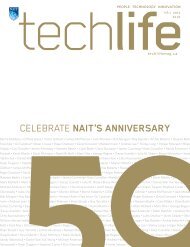SENSATIONAL
Read the full print edition - techlife magazine
Read the full print edition - techlife magazine
Create successful ePaper yourself
Turn your PDF publications into a flip-book with our unique Google optimized e-Paper software.
INNOVATEA livinglaboratoryIt’s the same kind of struggle that’s goingon in communities across Canada. Humanactivities, from agriculture to urbandevelopment, strain vital aquatic ecosystems.This has caught the attention of researchersin NAIT’s Biological Sciences Technologyprogram, who have been tracking the impacturban development is having on waterwaysand natural areas, using the SturgeonRiver watershed in Central Alberta as theirlaboratory.*“Our studies are designed to look at bestmanagement practices that can benefit theSturgeon River watershed, but can be appliedto watersheds elsewhere in Alberta andCanada and possibly globally,” says LaurieHunt, the program’s associate chair andsenior faculty researcher.— Frank Landry*This applied research program is funded by the AlbertaConservation Association, the Natural Sciences andEngineering Research Council of Canada and through a courtpenalty stemming from the Aug. 3, 2005 CN train derailmentand oil spill at Wabamun Lake.Danger: Thick icesnowmobilers should avoidsensitive parts of the SturgeonRiver and stick to designatedtrails in order to avoid killingfish, suggests new NAIT appliedresearch.Biological sciences studentsfound ice is thicker undersnowmobile trails becausecompacted snow removes athermal barrier, allowing cold topenetrate deeper. The conclusionwas drawn after measuring icethickness and water depth at 10sites along the Sturgeon Rivernear St. Albert, and Onoway, westof Edmonton. At each location, ameasurement was taken under asnowmobile trail and nearby, atan undisturbed location.“At some sites, under thetracks the ice was almost a metrethick and a few metres away theice was perhaps half-a-metrethick, so it was significantlydifferent,” says Debbie Webb,a biological sciences instructorand senior faculty researcher.That can be hazardous tothe health of shallow waterwayslike the Sturgeon. Thicker icetakes longer to melt in the spring,which can lead to more winterkill,according to the researchers. Aswell, thicker ice can fragment theriver during the winter, making itharder for fish to move betweendeep pools, where oxygen levelsare higher.“If the ice is too thick, thefish can’t get through,” saysstudent researcher LindseyOberst, who graduated from thebiological sciences program in2011. “What we found in quite anumber of areas was the ice wasfrozen right down to the bottom.”Oberst says it’s important forsnowmobilers to be aware ofthe impact they can have on theecosystem.38 techlifemag.ca










